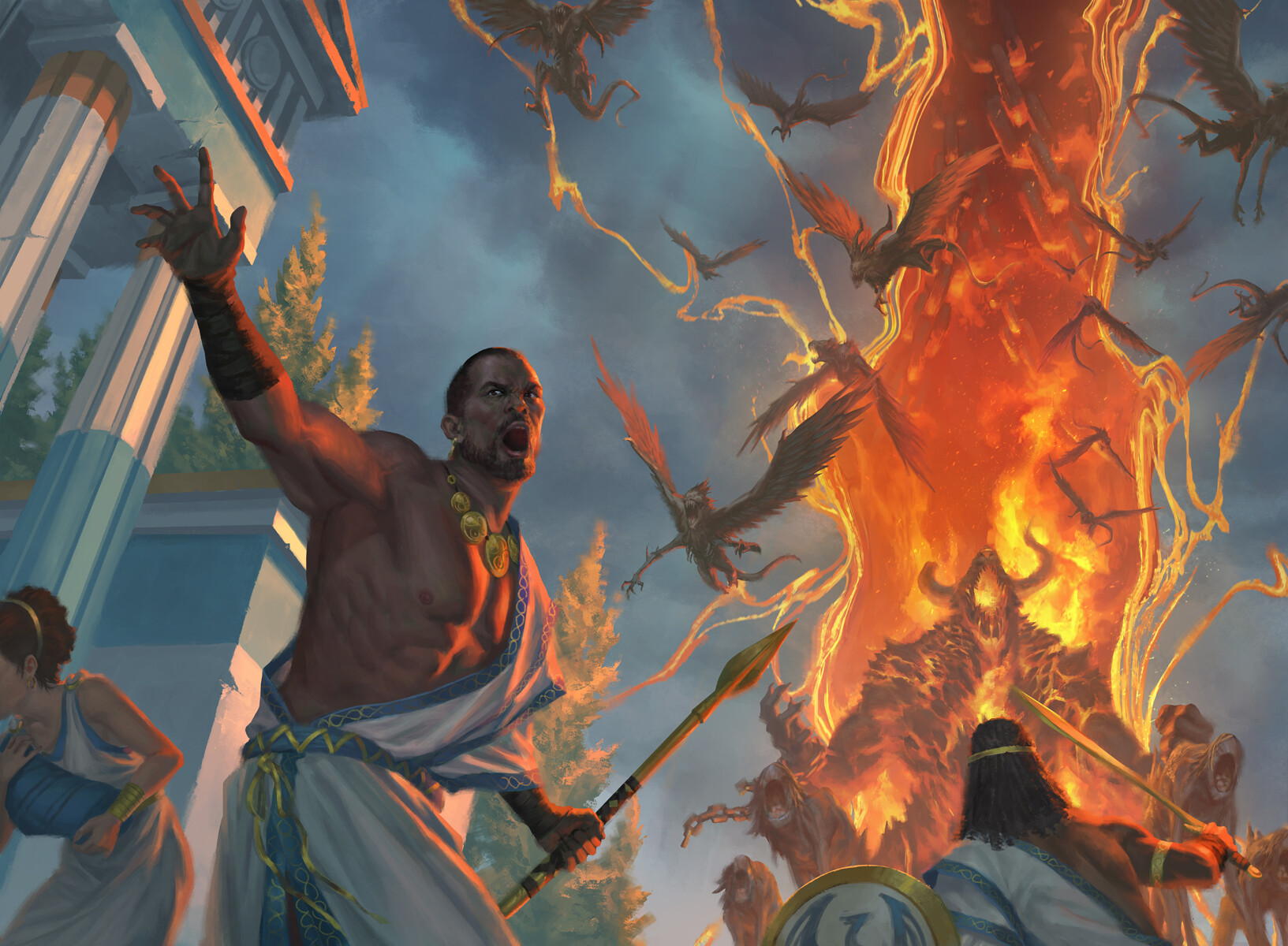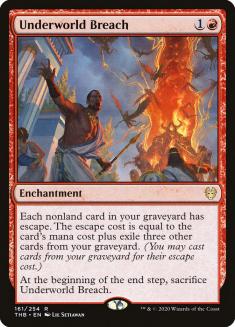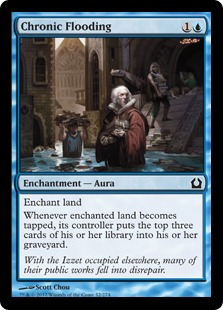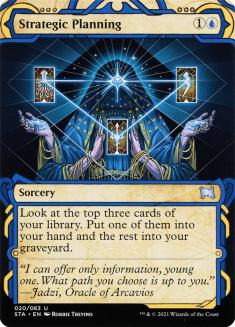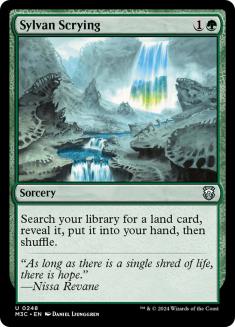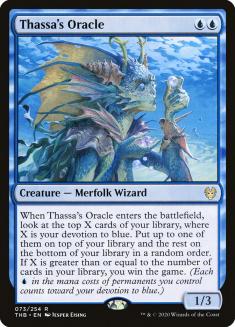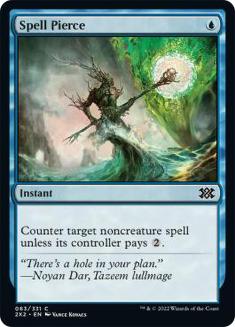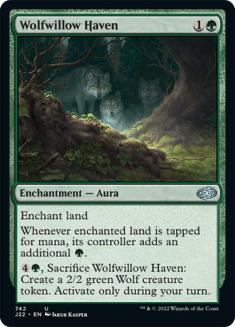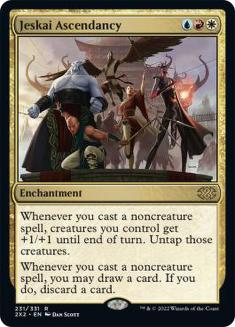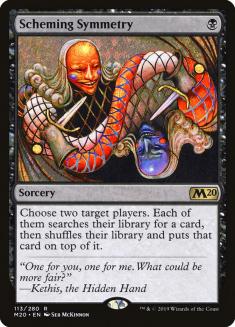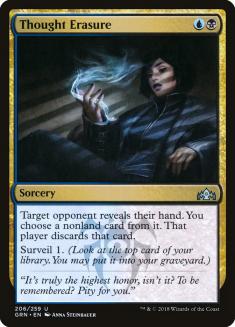Underworld Breach is just Yawgmoth’s Will. Let that settle in for a second. Roll it around in your mouth and really get a taste for it. See how it feels coming out of your mouth as you repeat it back.
Underworld Breach is just Yawgmoth’s Will.
Now that we’re on the same page, let’s begin.
Figuring It Out
When it comes to older formats like Pioneer, Modern, or Legacy, certain cards that might not have a huge impact in Standard can ultimately reshape an entire format. We’ve seen it quite a few times in the last few years, from Eldrazi Winter all the way back to Deathrite Shaman. Sometimes it’s on purpose, as they design cards to be functional or even powerful when combined with older cards. But occasionally, things get out of hand.
At other times still, they make cards that eventually shape entire archetypes, and everyone is just fine with it. Past in Flames, for example, was created knowing that it could have lasting implications on older formats. Much like Past in Flames, Underworld Breach utilizes the graveyard in a way that isn’t really feasible in Standard. Ritual effects that generate extra mana are used to fuel cards like these, providing players with a viable “Storm”-style strategy.
The design on Underworld Breach is even more interesting than Past in Flames because it allows you to play cards of any sort while also allowing them to be cast more than once. Because of that, cards that self-mill are inherently valuable. On the first day people saw it, someone figured out that it was a deterministic kill with Brain Freeze and Lion’s Eye Diamond in Legacy. Since you can cast your win condition out of the graveyard, all you really need to do is mill your entire deck. Once you do, winning becomes trivial.
The easiest way to do it in Pioneer is as follows:
With these three cards, you can mill your entire deck. Every time you tap a land for mana, you mill three cards. Every time you tap two lands, you cast Hidden Strings from the graveyard exiling the same three cards you milled over. Rinse and repeat until your entire deck is in the graveyard. How you win from there is entirely up to you, though most people are utilizing Thassa’s Oracle.
If you have Chronic Flooding already on the battlefield, the combo costs only four mana. Cast Underworld Breach and then Hidden Strings. If you need, you can cast Hidden Strings from the graveyard, which means Chronic Flooding is a great way to find your other combo piece. Unfortunately, you need to actually draw Underworld Breach, but that’s what the rest of your deck is for! If you have more mana than that, let’s say six, you can cast all three cards at the same time. And if your graveyard is full for whatever reason, you can usually win just by casting Underworld Breach with four extra mana at the ready.
One of the easiest ways to generate some extra mana, so you can cast multiple spells every turn and make Hidden Strings into a real Magic card, is to pair it with an already existing deck: Lotus Field. Hidden Strings is already seeing a lot of play in Pioneer. When you combine it with a land (or permanent in general) that taps for three mana, untap effects become a lot more powerful. And if you’re in the business of casting a few sifting spells to find your combo, having that extra burst of mana and turning Hidden Strings into a functional card outside of the combo is huge!
There are also a few other deterministic kills with Lotus Field, including pairing it with Hidden Strings and Tome Scour. For four mana, you get to untap both Lotus Field and another land, cast Tome Scour on yourself twice, then repeat. You don’t even need Chronic Flooding! Tome Scour is also a nice way to fuel Dig Through Time and find the other two pieces of the combo should you already have Underworld Breach at your disposal.
And that’s the rub with cards like Underworld Breach. From a design perspective, it seems like a really cool new way to utilize the graveyard. But Magic has a funny way of breaking its own game engine when you make unique cards. Devotion turns Frostburn Weird into an all-star. Dredge and Vengevine make Insolent Neonate a reasonable enabler. And here we have Underworld Breach turning Chronic Flooding, unplayable Draft chaff, into fuel for the combo, Dig Through Time, and an integral part of a deterministic kill.
Because the combo is new, and there aren’t any definitive ways to build it just yet, I’m going to showcase a few different ways other people have had success with it so far. And while there are some really powerful ways to disrupt the combo, it’s important to understand that these Underworld Breach decks are entirely in their infancy, and combo decks like these are very tough to build on the first go. Oftentimes you’ll see the first iteration to go 5-0 on Magic Online or Top 8 a PTQ become the default version, even if it isn’t necessarily the best. Sometimes, the combo is strong enough to carry, even in a sub-optimal build.
Regardless, we have a couple of different variations to talk about, so let’s get to it.
Creatures (5)
Planeswalkers (2)
Lands (24)
Spells (29)
- 4 Sylvan Scrying
- 4 Strategic Planning
- 4 Tome Scour
- 4 Chronic Flooding
- 4 Hidden Strings
- 4 Dig Through Time
- 1 Blink of an Eye
- 4 Underworld Breach
Sideboard

This iteration puts less emphasis on the Lotus Field aspect of the deck, instead utilizing it like a mana battery. If it’s hard to spot the difference, just look for Pore Over the Pages. But while we aren’t full-blown Lotus Field combo, it does help you generate extra mana in some spots, which occasionally allows for a Dig Through Time into your combo on the same turn.
Speaking of Dig Through Time, this iteration puts it to work, and I’ve even considered playing one or two Treasure Cruise to help gain a burst of resources against opponents who are interacting with you a lot. With Tome Scour and Chronic Flooding, it isn’t that hard to fuel your graveyard, but playing more than four delve spells without access to fetchlands is tough. Luckily, Strategic Planning helps a bunch!
Sylvan Scrying is solid here, as it just helps you find Lotus Field. And while Lotus Field proper isn’t part of the combo, it’s certainly good at helping you get across the finish line. Making Hidden Strings into a functional card just turns it from “combo piece” to “valuable point of resource generation.” It’s the difference in having a useless Splinter Twin versus a planeswalker like Saheeli Rai that can help you churn through your deck. The extra deterministic kill with Tome Scour and not relying on Chronic Flooding is also pretty sick.
I love the sideboard plan of Thing in the Ice, as it lets you pivot in the face of hate and a lack of spot removal. But if the opponent knows your strategy, it becomes a lot less effective. But once you know what hate your opponent is going to throw at you, sideboarding becomes a lot easier. Return to Nature basically always comes in, as your opponent will likely have some artifact or enchantment that you need to kill.
This iteration of the deck is a hybrid of sorts, but you’re going to have to check out the others before you make your own decision about which is best. This one is my favorite:
Creatures (4)
Lands (23)
Spells (33)

I had a sneaking suspicion that an Izzet version of the archetype was going to be really powerful, if only because the combo doesn’t really need Lotus Field to work. The green was always weird to me because you’re effectively splashing for a bit of mana acceleration and some sideboard ways to kill enchantments like Leyline of the Void.
My first instinct was to take a hot knife to this deck and start slashing stuff. Witching Well? I don’t get it. You don’t generate a ton of mana. And why four copies of Thassa’s Oracle? You only need one to combo! I mean, I get why you would play two, in case it dies and or gets exiled somehow, you can still win. And Omen of the Sea? That can’t be right! How is that better than Opt!? But then something clicked, and I realized how genius this list actually was.
This deck can use Thassa’s Oracle as a dig spell. That’s the draw. That’s the genius behind it. Something as simple as reading the card and using as it was functionally intended is all it takes to understand what the true strength of this deck is. All the weird permanents like Witching Well and Omen of the Sea fuel devotion and let you look at the top five or six cards to help find Underworld Breach. It’s the most important piece of the combo after all, and if you don’t actually find it you can just put all of them on the bottom of the deck. Your consolation prize is a 1/3 that can play defense quite well, and also adds two devotion to the next Thassa’s Oracle.
This version is a little slower than the others, but it’s also outrageously consistent. Thanks to the entire deck being some sort of dig effect, you can find your combo quickly. And if you’re able to resolve Chronic Flooding on the second or third turn, you can kill your opponent on the fourth turn quite easily. And for a new combo deck, having the ability to combo quite easily on the fourth turn is pretty scary.
Spell Pierce is also secretly excellent right now. When Pioneer first started, I hated it. I just thought it was a super-weak card in a format dominated by Llanowar Elves. But as the format balanced out and went through some bans, now is a time where Spell Pierce is actually good. More planeswalkers are running around, and midrange/disruptive decks have picked up a ton of steam. And giving a combo deck a one-mana protection spell that can be played in the maindeck is very strong.
This version of the deck is the one that actually scares me, because it proves that only a certain portion of the shell actually matters, and the rest of the deck is fairly customizable. This iteration took something as innocuous as the dig ability on Thassa’s Oracle, already a part of the kill condition, and put it to work. I doubt I would have ever thought about that, simply because that aspect of the card feels pretty weak. Much like the “draw a card” ability on Jace, Wielder of Mysteries, you’re not really playing it for that. You play it because it has a “win the game” clause.
I also love that this deck can win through graveyard hate pretty easily if the opponent doesn’t put a clock on you. Chronic Flooding is not a card your opponent should be countering or making you discard. And if you’re able to get one or two on one of your lands, you can eventually mill your entire deck. It’s much easier than it seems at first glance. And when that happens, all you have to do is build up a little devotion then cast one of your four Thassa’s Oracle to actually win the game.
I’ve already beaten Leyline of the Void once, and I’m curious how often I’m going to in the near future.
Next up:
Creatures (5)
Lands (24)
Spells (31)
- 4 Sylvan Scrying
- 4 Strategic Planning
- 4 Chronic Flooding
- 4 Hidden Strings
- 3 Dig Through Time
- 4 Pore Over the Pages
- 4 Wolfwillow Haven
- 4 Underworld Breach
Sideboard

This is arguably the slowest version of the three decks, but it can win the game without interruption on the fifth turn very easily. That’s not high praise, as you don’t interact with your opponent to slow the game down much, but this iteration is incredibly resilient to discard and counterspells. You can generate so much mana with Lotus Field and Thespian’s Stage that winning becomes trivial. However, having the “I win” button rolled up into a tight Underworld Breach package is a lot better than the clunky version we’re used to seeing.
This version Top 8’ed a recent Pioneer Challenge on Magic Online, a relatively difficult tournament to succeed in, with an archetype that no one had really built before. This version puts Pore Over the Pages to great use, acting as a dig spell and mana generation to boot. Putting an emphasis on the Thespian’s Stage package to fuel Pore Over the Pages is very smart deckbuilding, though it does probably need something to help accelerate your overall clock.
In my experience, Wolfwillow Haven was useless, and you’d be better off trying out something like Arboreal Grazer. Simply put, Wolfwillow Haven can’t really be played on the second turn without exposing yourself to your own Lotus Field. Generating an extra green mana is also the same as generating a colorless mana for the most part. And while untapping a land that generates extra mana is great, I found you just don’t have the time to “assemble your own Lotus Field.” It’s just not feasible. Not generating extra blue mana also means it’s much harder to combo out while untapping the land with Wolfwillow Haven on it.
Figuring Out What’s Next
So we have a few different variations to work with, but which one’s best? In my experience, the one that felt the most consistent and fastest was the one featuring Tome Scour. If anything, it just plays more copies of Dig Through Time and can fuel them. It also has more combo potential, as it doesn’t necessarily need Chronic Flooding to go off. But all this just makes me feel like we’re missing something.
Like the first iterations of Splinter Twin, we’re too entirely focused on the combo for my taste. I think it would benefit us to look at hybridizing this combo with another, while maybe figuring out the best mode to pivot away from the archetype should things go awry. Can we fit Thing in the Ice into the maindeck? Would it even be worth it? What about trying to turn this into an Arclight Phoenix strategy?
The core of Underworld Breach, Chronic Flooding, and Hidden Strings is a fairly tight package. Everything else feels customizable. I personally love four copies of Dig Through Time, if only because it helps find the rest and is fueled by Chronic Flooding. I mean, with how little the green actually adds to the deck, I’d expect a different splash color to add some much-needed interaction or protection to your deck. That other color might introduce an entirely new combo!
Jeskai Ascendancy has long been a “problematic” card in that it functionally breaks the game by utilizing the untap mechanic on mana creatures. But what it also does is fuel the graveyard, dig for stuff, and give you a way to generate a ton of extra mana. Maybe this is the card you want to pair with Underworld Breach? Unclear, but hybridizing the two archetypes seems fundamentally simple.
Since one of the big draws for playing green is the ability to kill an artifact or enchantment, I just wanted to point out that Fragmentize kills most of the same stuff in the format. If you want to play white instead, you’ll only be losing out on the mana acceleration.
Scheming Symmetry is incredibly powerful in the right shell, but how about in a deck that can play Tome Scour to keep your opponent from drawing their card?
Two disruptive elements, one of which can actually fuel your graveyard slightly, these can be nice ways to preemptively break up your opponent’s draw while also protecting yourself from their disruption. If the format is slow, this type of interaction is very strong in a combo deck that can kill on the fourth turn. And when everyone is playing midrange or control decks, this type of disruption is at its best.
I expect either black or white to be the splash color that allows for an alternate win condition. Green seems primarily poised for acceleration, while both white and black can give you more disruption or alternate methods of attack. The truth is that this archetype is beyond my regular scope of normal deckbuilding, and it’s extremely hard to test on Magic Online because it involves clicking a thousand buttons to actually win the game.
That said, it’s an interesting new combo in a relatively new format. There are a ton of eyes on Pioneer right now, if only because the Players Tour in a few weeks is using the same format. If you want the best version of the deck, you’ll likely find it there, though it will take a few weeks. And as is customary, most people playing in that tournament will keep tight-lipped with all the sweet, sweet technology.
If you want to stay on top of all the cool stuff happening in Pioneer, make sure to check out my stream regularly. I’m on daily around 3pm PT, always trying new things, and this Underworld Breach combo is certainly catching my attention. And while it might be frustrating to play on Magic Online, it’s not like I don’t have experience with this type of thing in the past.
I just need to flex my Splinter Twin muscle memory!

